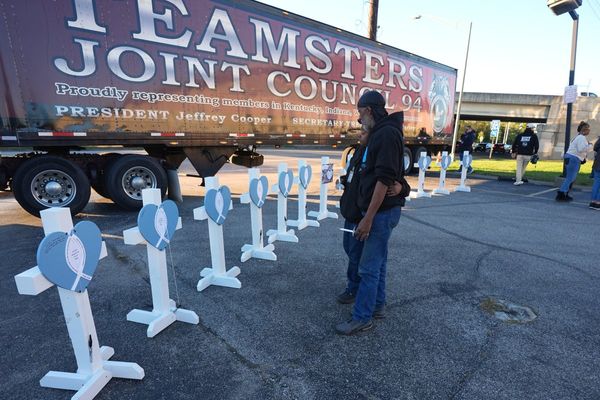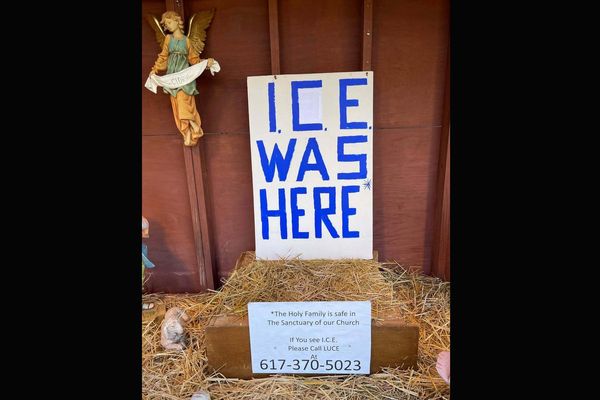In the 1970s, while women took to the streets to march for their rights, Chris Wilson broke a different kind of glass ceiling … by heading underground.
Chris was told in 1978 that she was the first woman to work in an underground mine in Tasmania after she was hired at the Renison Mine in the state's west.
She was among the very first women working underground in Australia. In fact, until 1986, West Australian mine operators could be fined $500 if a woman was caught beneath the surface.
"I've always thought back on that time as the best years of my life," Chris said.
Decades on, she is still fascinated by the minerals in Tasmania's west.
As a tour guide, she takes people to places of interest and beauty near Queenstown including rainforests and historical mines.
She also shares her love for Tasmania's amazing mineral treasures through her work as an artist.
Was it fate?
Chris Wilson had a roundabout journey to the mines, training as a teacher with majors in arts and geology — a hint of what was to come later in life.
Her first teaching post was in Queenstown, a mining heartland in Tasmania's west.
"I fitted into the town quite easily, enjoyed my teaching and exploring all the old mining tracks around the area. I was right in my element," she told ABC Hobart's Kylie Baxter.
But when the education department moved Chris to Burnie she hated it, so started looking for work that could take her back to the west.
There was a job going in Zeehan as a prospecting hand, so she applied and got it.
It was outdoors and manually difficult, but that was no problem for Chris who enjoyed the role for 18 months until her employer wound down their prospecting ventures.
How about underground?
Chris says she was perusing a newspaper looking at geology job listings on the west coast when she saw an intriguing ad.
"The ad had a very unusual bit of postscript to it, which said, 'Females need not be deterred from applying for this very interesting position'," she said.
It was for a mining position as a geological technician at the Renison tin mine.
It was only after successfully getting the role that Chris found out the head geologist, Lindsey Newham, was hoping she would see the advert and apply.
At first, her job was above ground working with surface geologists.
Then her boss asked her if she was interested in working underground.
Her answer was a resounding "Yes please".
Even though she was ready and able, Chris's boss had to write to the government in Hobart to get permission for her, a woman, to go into the masculine domain of underground mining.
"So, I had to wait for this letter to come back saying, yes, I could do it," Chris said.
Permission was granted and she thrived underground.
Before long, Chris was promoted to the role of underground geologist and became responsible for the geology of half the mine.
She would supervise the drilling rigs, inspect rock faces after blasts, take and analyse samples, and write reports.
Not all sunshine underground
Not everyone was as supportive as Chris's boss, and she had to fight off some "challenges" from some of the men who were not happy she was in their midst.
"They were out to test you to see 'Do you really think you can hack this underground work?'," she said.
She recalls driving her vehicle to a newly blasted underground rock face to take a sample before suddenly hearing a big roar and seeing "the big lights of a massive ore truck".
"They are about 35-ton trucks, they're huge things," she said.
"And the driver was sitting up there in the cabin watching and waiting."
Chris says she knew it was a test.
"I hopped in my vehicle and he basically forced me to reverse out of this tight space between his truck and the rock wall with only a centimetre or two to spare either side," she said.
Paved the way
While Chris was the first woman known to have worked underground in the state, women had long been part of the history of mining communities in the west.
"I think the lot of the woman was mainly to support her husband and raise the family and keep the household going … there was little involvement in the actual mining activity as far as I'm aware," she said.
She went back to visit with other former Renison employees 25 years after working in the mine and says she was delighted when the group was met by a woman who worked underground and would be showing them around.
"I thought, 'In the very beginning, I paved the way for females to be accepted underground'," she said.
"Here was this young woman doing that work."







